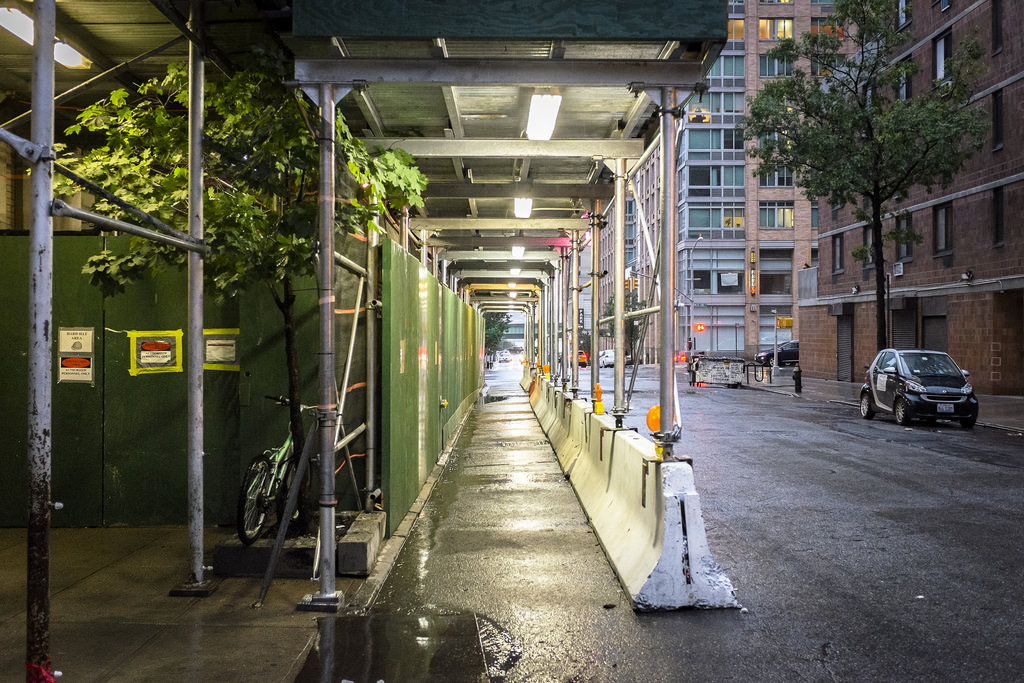Pedestrians are all too aware of sidewalk sheds, the makeshift plywood, sheet metal, and concrete scaffolding tunnels that shield city street walkers from debris from nearby construction projects. While the sheds are functional enough, New York believes they can be aesthetically pleasing, too.
Curbed NY reports that the New York Building Congress will hold a competition where architects and other professionals in the construction industry will submit proposals for alternative sidewalk shed designs. New York, which has nearly 200 total miles of sidewalk sheds, is seeking a concept that is practical but that also looks good.
"In the course of their daily lives, millions of New Yorkers are forced to encounter sidewalk sheds that can best be describe as dark, constrictive, and forbidding. It's time we stopped treating their design as an afterthought," Tom Scarangello, Chairman of the New York Building Congress, said in a statement.
The number of permits for sidewalk sheds in New York rose 25% from 2009 to 2014, and some sheds could stay up for several years whether construction is occurring or not. Local businesses have also been negatively affected by the sheds, and it turns out the structures aren't always safe.
The contest's four winners will be announced in September, and they will receive $10,000.
Related Stories
| Sep 14, 2011
Lend Lease’s role in 9/11 Memorial & Museum
Lend Lease is honored to be the general contractor for the National September 11 Memorial & Museum project at the World Trade Center site in New York City.
| Sep 14, 2011
Thornton Tomasetti’s Poon named to the Council on Tall Buildings and Urban Habitat’s Board of Trustees
During his 30-plus years of experience, Poon has been responsible for the design and construction of super high-rise structures, mixed-used buildings, hotels, airports, arenas and residential buildings worldwide.
| Sep 12, 2011
PVs play new roles as a teaching tool
Solar installations are helping K-12 schools around the country save money and teach students the intricacies of renewable energy sources.
| Sep 12, 2011
Living Buildings: Are AEC Firms up to the Challenge?
Modular Architecture > You’ve done a LEED Gold or two, maybe even a LEED Platinum. But are you and your firm ready to take on the Living Building Challenge? Think twice before you say yes.
| Sep 12, 2011
First phase of plan to revitalize Florida's Hialeah Park announced
This is the first project of a master plan developed to revive the historic racetrack.
| Sep 9, 2011
Kauffman Center for the Performing Arts in Kansas City opens this month
Theatre Projects played the lead role in theatre design and planning as well as in engineering the customized theatre equipment. BNIM in Kansas City served as the executive architect.
| Sep 9, 2011
$22 million investment made in energy efficient building maker
The buildings use at least 25% less energy than the strictest building codes in the U.S., and as much as 80% less energy in certain parts of the country.
| Sep 8, 2011
Two promoted at ajc architects
ajc architects announced the promotion of Joshua W. Greene, AIA, NCARB, LEED Green Associate to Associate Principal of the firm. The firm also announced that Kent Rigby, AIA, has been promoted to Associate Architect.
| Sep 7, 2011
KSS Architects wins AIA NJ design award
The project was one of three to win the award in the category of Architectural/Non-Residential.

















